Building Your Dream Equestrian Property
by Nikki Alvin-Smith
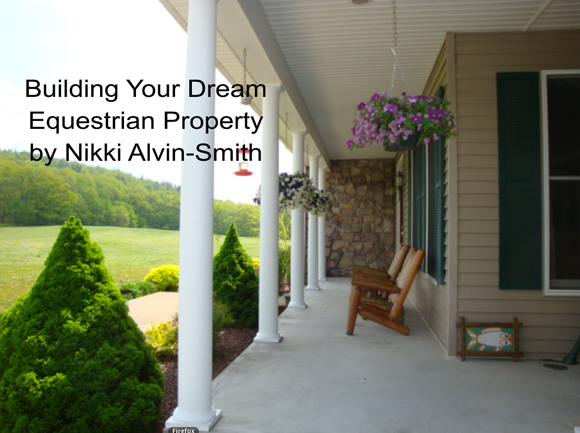
Do you dream of finding the perfect place to develop your own equestrian paradise? Perhaps you’ve thought of opening a horse training/boarding business, a dude ranch, or simply want to keep your own horses at home instead of at livery. Perhaps you picture yourself riding the trails or perfecting your dressage work.
Most horse folks eventually arrive at the determination that keeping their horses themselves would be a perfect life. We thought it would be fun to take a look at a property that is actually presently for sale and walk you through and give you some tips and pointers along the way. Possibilities are quite endless.
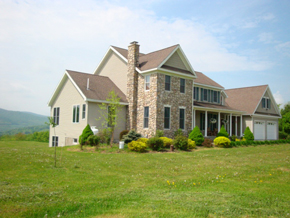 The example property, located in the majestic Catskill Mountains at Stamford, New York, is offered with 180 acres of mixed woodland and open hay fields and the house itself is the gentleman farmer’s dream home with lofty ceilings, a fine kitchen and four bedrooms. There is an ample deck for outside dining and the downstairs is a massive space perfect for entertaining.
The example property, located in the majestic Catskill Mountains at Stamford, New York, is offered with 180 acres of mixed woodland and open hay fields and the house itself is the gentleman farmer’s dream home with lofty ceilings, a fine kitchen and four bedrooms. There is an ample deck for outside dining and the downstairs is a massive space perfect for entertaining.
It even encompasses a sauna, and full bathroom downstairs where you can pop in from outside after a long day riding and working in the barn or a day out snowmobiling and clean up. Shortly to be followed by a beverage and refreshment for all at the full size wet bar or warm up by one of the many fireplaces in the home. Here are some photos. They explain the beauty of the home much better than I can.
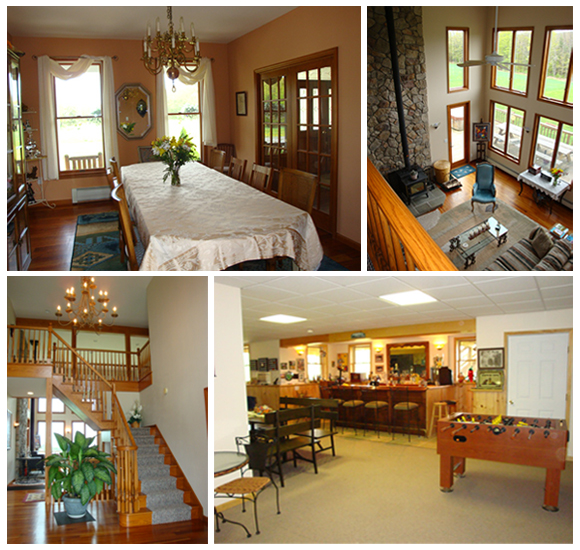
Yet I digress. To the horse portion!
The property is split across a small country road which is peaceful and quiet due to the fact it is located at a dead end so traffic is not a problem. When buying land split by a road crossing a busy road with horses is not a sound idea. Regardless of what signage the county will put out there drivers are often not very obliging about heeding the warnings and slowing down. In this case the road is not an issue and actually gives a bonus because it would allow you to split a business on one side from your private yard from the other. This split would allow you to maintain your privacy at your home. Something to think about. People often forget that boarding barns with 40 stalls can mean 40 cars to park, 40 people and their families/friends using bathroom facilities and some amount of noise with this traffic. So plan for that when you design the facility if you are thinking of going the boarding route.
On one side of the property sits the beautiful custom home, with 40 acres. There is a huge flat ten acre field that is the perfect spot to build your barn and pastures. You would be able to sit on your porch and watch your horses peacefully grazing at the end of a busy day, while you sip a glass of wine and reflecting on all that is good in your life. The sides of the field are prettily protected by woodland and the remaining part of the 40 acres is woodland with groomed trails. Perfect for a quick cool off on the trail after a workout in the arena.
If you built your barn, with possibly an attached indoor here, or an outside arena, you would be able to place it in the center and have the paddocks extending all around with some parking in the front. The placing of paddocks is very important. You do not want to be walking horses long distances for turn out and whether you are setting up a horse breeding operation and will be leading mares and foals in and out, or have boarders visiting, no-one wants to be taking extensive walks in all weathers just to fetch their horses. It is also a sensible idea to leave a swath of grass (i.e. double fence) between fence lines so horses cannot reach out to each other and argue over the fence. This can result in damage to both the horses and the fences.

Keeping the pastures close to the barn will also allow a less expensive provision of running water to the troughs in the fields. You will probably want to drill a well for the barn’s exclusive use to service both water in the barn, and the bathroom facility you will surely want to have there. A quick piece of advice, if possible use a Pex product, a plastic pipe that expands if it freezes versus copper where you can.
When siting your barn the direction of the sun is important for both light and warmth. Also consider the prevailing wind direction. This will also affect how you place run in sheds for the pastures. A run in shed should always have its back to the prevailing wind and not be located at the lowest part of the pasture where water will constantly drain into it, and if possible add some gravel through gateways and in front and under the shed to keep these area from becoming muddy.
Barn design should include areas for tack, feed and hay storage, shavings or bedding storage, possibly a wash stall, and address good air circulation. Also consider safety. The aisleways should be wide enough for two horses to safely pass each other, the stall walls should be solidly divided (especially if you are thinking of a boarding operation-these types of walls will make it so that horses cannot intimidate each other) and stall grills high enough to ensure that youngsters don’t put a foot through them. Floors should have drainage, so they can be properly disinfected. Poor air quality in barns is caused by general lack of ventilation, unsanitary bedding and poor stall maintenance, and overhead hay storage. All these issues can contribute to respiratory disease in horses. For more on this topic consider buying the DVD ‘The Horse’s Respiratory System’ from Advanced Equine Studies. There is whole section within the five plus hours of education here, that studies barn design and the effect it has on the horse’s respiratory health. The stalls should also be matted to protect the horse’s joints and complete the easy maintenance. Sliding door systems are better than doors that open into the aisle way as they are safer and tidier in appearance. Also consider if you have dutch doors that open to the outside, it is important to have some sort of roof overhang to protect the horses from the hot sun and windy/rainy weather. These doors in particular should be high enough to be safe. Many horses dive over stall doors and get hurt so be aware of this possibility.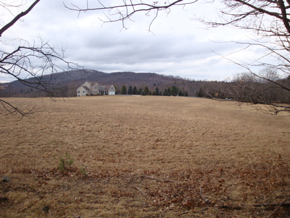
When designing the barn also think about the lighting. This will also affect the placement of the outdoor arena if you want one and if you think you might want to light it. Bringing in electric to this particular property is simple as the road service is handily placed. It is a good idea to have a separate meter for the barn/indoor if you are operating it as a business, from both a billing standpoint and in case you want to offer the facility for lease to a trainer at a later time.
For fencing your pastures there are many options. The cheapest but not necessarily the safest or the best looking is electric tape or rope. There are maintenance free options such as PVC and other manmade products and then there is traditional board fencing. This property is located in prime wood logging country and buying locally produced oak boards is an easy option or you can shop pressure treated boards from a box store or local merchant. I will not delve into all the options of fencing here. Suffice it to say with this land being level and having a good top soil base with good drainage will make life a lot easier. Both on the install and design.
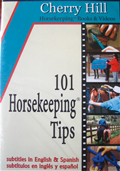 There are many great resources available to help you build and maintain your horse property. For example Cherry Hill’s DVD 101 Horsekeeping Tips runs through handling, grooming, feeding, health care and tack and has a section on facilities with seventeen tips to help make life easier.
There are many great resources available to help you build and maintain your horse property. For example Cherry Hill’s DVD 101 Horsekeeping Tips runs through handling, grooming, feeding, health care and tack and has a section on facilities with seventeen tips to help make life easier.
So now your horses are safely housed and grazed it’s time to think about what you want to do with them. Many folks just get out and trail ride. From an investment standpoint, and a training standpoint, some sort of outside arena is paramount. There is a wealth of information on how to build the perfect arena and by far the most important is the footing. Footing mistakes can be costly. Also be aware that products that are rubber based when used have been found to affect both horse and rider by small particles of rubber entering their respective lungs. A factor also covered in the Advanced Equine Studies DVD. For the arena you should also consider how you are going to water it, drain it and it should always be fenced for safety.
Now you have built this amazing dream property you need to consider how you are going to maintain it. You will need a tractor or some type of hauling equipment for manure, a harrow for the arena and also consider how and where you are going to dispose of the manure. You can set up a concrete bunker (not too close to the barn because of the flies/insect issue and smell but also not too far away for winter use), the advantage of this is you can compost it and then spread it at a later date over the fields or garden. One innovative barn I know sells their manure to a large supermarket who supplies the trailer for its deposit and then picks it up and delivers it for use to their own vegetable farm. Recycling is always good!
This equipment will also require some kind of storage. So add a building for that. In the case of this property it is time to turn to the 140 acres mentioned that are across the road and the barn and cabin that presently exist. While the house and the 40 acres just discussed can be purchased alone, you can also purchase the entire property with the total 180 acres. This extends this property into a true horse lover's delight.
You can use the cabin to house a groom, manager or use it as a guest house for visiting clinicians and family. It is located close to the big gambrel roofed barn and would make a perfect caretaker cottage. The barn itself is made of large lumber and you can access the top portion from the roadside as it is a bank barn. That is wonderful for easy hay storage, ATV, snowmobile or equipment storage.

The first floor has high ceilings, no cow stanchions or dairy operation to remove (which is an expensive task if you have to complete that renovation), and has lots of space to add stalls. In this case you could use this as your main barn and not build a new barn at all, just convert this one and save the large 10 acre field by the house for hay, grazing or riding. Or it could also be your boarding barn, which will help keep them away from your own private establishment avoid risks to your own horses and assure your privacy. A neat source of income and additional barn help. You could also use the first floor for equipment storage, or as a workshop or artists studio. The possibilities are endless.
The acreage on this side of the road provides you with hay fields (which you can cut or sublet to a local farmer). To learn more about haymaking and storage check out this wonderful article ‘The Seven Deadly Sins of Haymaking.’ This property also boasts miles of groomed trails and even includes a one acre pond. Apart from riding on your own property it is always fun to be able to ride out elsewhere without needing to trailer. Many riders look for properties with adjacent State Parks or other opportunities to ride out. Always a good thing to find. On this particular property you can ride down and join a 26 mile riding trail that used to be a railroad. The track is very pretty, and it winds through several villages including the quaint “Queen of the Catskill’s” town of Stamford and through farmland south through South Kortright, Hobart and Bloomville. Riding this trail is a wonderful experience, and you could even stop in the village for a snack.
The fun of building and designing your very own horse farm cannot be understated. That joyous day when you move in your first horse or step into your own private arena is worth all the work that goes into your farm.
I have kept this article general for an overview of what is involved in the build and design of a horse farm. Coming in future editions of Catskill Horse will be more in depth coverage of types of fencing, types of stalls and equipment so please check back regularly.


